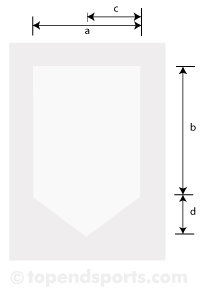A sweat collection patch is an adhesive pouch applied to the skin, that can be used to determine the sweat rate for that particular part of the body, and also provide a sample that can be analyzed for electrolyte content. This method is suitable for measuring sweat at various sites around the body. If you wish to measure the total body sweat rate, you can use the body weight method. Another method for collecting sweat samples is using Absorbent sweat collection patches.
test purpose: to use sweat patches applied to the skin to collect a sample of sweat for measurement.
equipment required: sweat patches, razor, alcohol wipes, pipette, gloves, storage container, small scales, sweat analyzer (or external laboratory).
patches: The sweat collection patches should be prepared of standard known size (the area of collection is required for rate calculations). A popular method is to use paraffin film to cut out the desired shape which is stuck onto a rectangle of clear tape. See the diagram for an example.
pre-test: Explain the test procedures to the subject. Perform screening of health risks and obtain informed consent. Prepare forms and record basic information such as age, height, body weight, gender and test conditions. Calibrate equipment. See more details of pre-test procedures.
 patch placement: There are many possible skin sites to use for sweat collection. The site used may depend on the purposes of testing. Commonly used are the upper back, chest, forearm, thigh and forehead. If standard sites are used, they need to be measured up and marked for correct placement.
patch placement: There are many possible skin sites to use for sweat collection. The site used may depend on the purposes of testing. Commonly used are the upper back, chest, forearm, thigh and forehead. If standard sites are used, they need to be measured up and marked for correct placement.
procedure: Prepare the skin by shaving off any hair and clean it with alcohol wipes and allow it to dry. Another method is to wash the area with de-ionized water. Place the sweat patch on the desired site. After a pre-determined exercise time, the top of the patch is opened and a pipette is used to siphon off the sweat. The sweat is then transferred to a container and weighed.
results: sweat rate can be calculated by dividing the volume of sweat collected by the skin area. If using a patch like the example illustrated, the area of skin = ( a x b ) + (c x d). The collected sweat can also be sent for analysis to determine electrolyte composition. Alternatively, you can use absorbent sweat patches made to do the same job.
reliability: If the subject is to be retested, or athletes are being compared, accurate placement of the patches is very important for reliability. It is also important to standardize the testing conditions, so that the exercise intensity, duration, clothing, and environment are the same.
disadvantages: sweat composition and sweat rate vary across different regions of the body.
advantages: sweat collection can be done during a range of exercise modes
Similar Tests
- Sweat Collection for Analysis — collecting sweat using patches to measure electrolyte composition.
- Whole Body-Washdown — method for whole body sweat collection.
- Sweat Loss Measurement — whole body fluid loss measurement using body weight changes.
- Sweat Monitoring — skin monitors to measure sweat rate and composition.
- Urine color testing — assessing body hydration by looking at the color of urine.
- Urine specific gravity — using a refractometer to measure the density of urine.
Related Pages
- Sweat Analysis Methods
- Hydration for sport: a collection of articles
- Measuring dehydration


 Current Events
Current Events